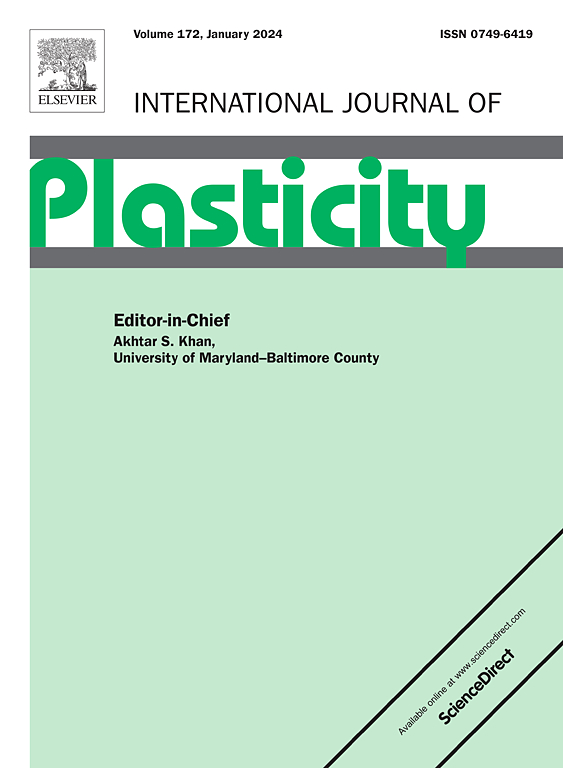The role of cryogenic treatment in the relaxation behavior of the elastically rejuvenated metallic glasses
IF 9.4
1区 材料科学
Q1 ENGINEERING, MECHANICAL
引用次数: 0
Abstract
This research investigates how elastically pre-loaded Zr52.5Cu17.9Ni14.6Al10Ti5 metallic glass (MG) subjected to cryogenic treatments (CT) affects its relaxation behavior and mechanical properties. The findings reveal that as the elasto-static compression loading (ECL) stress and duration increase, a noticeable improvement in structural rejuvenation will be induced due to the increase of the free volume. From the perspective of the atomic-level stress theory, the dilated atomic structure induced by ECL helps to achieve a synergy of strength and plasticity after CT. The shrinkage after cooling triggers the coalescence of the hard elastic matrix with the soft regions, which results in free volume annihilation and induces partial structural relaxation. Hence, high density regions with lower activation energy and higher yield strength are generated, manifesting an overcoming the strength-plasticity trade-off in MGs. Further investigations show that the β-relaxation activation that occurs after the activation of a small concentration of local low-viscosity regions is closely related to β′-relaxation. It is evidenced that with increasing of ECL stress and time that followed by CT process, the activation energy of β- and β′-relaxation and the viscosity of local liquid-like regions are decreased, while the concentrations of the defective flow units of β- and β′-relaxation are increased. Moreover, ECL and CT can induce structural modifications manifesting in the decrease of the activation energy and the increase of the shear transformation zones (STZs) volume, as compared with the as-cast state. The generalized Maxwell and free volume models serve as the frameworks for understanding the phenomena. These results offer insights into the relationship between the local liquid-like regions excitations and secondary relaxations with the mechanical properties, to develop advanced MGs with fascinating properties.


低温处理在弹性回春金属玻璃弛豫行为中的作用
研究了低温处理(CT)下弹性预加载Zr52.5Cu17.9Ni14.6Al10Ti5金属玻璃(MG)对其松弛行为和力学性能的影响。研究结果表明,随着弹性静压加载(ECL)应力和持续时间的增加,由于自由体积的增加,结构返老还老的效果会明显改善。从原子水平应力理论的角度来看,ECL诱导的膨胀原子结构有助于CT后强度和塑性的协同。冷却后的收缩引起硬弹性基体与软区结合,导致自由体积湮灭,引起部分结构松弛。因此,产生了具有较低活化能和较高屈服强度的高密度区域,表明克服了mg中强度-塑性权衡。进一步的研究表明,小浓度的局部低黏度区活化后发生的β′弛豫活化与β′弛豫密切相关。结果表明,随着CT处理后ECL应力和时间的增加,β-和β ' -弛豫活化能和局部类液区粘度降低,β-和β ' -弛豫缺陷流动单元浓度升高。此外,与铸态相比,ECL和CT可以诱导结构改变,表现为活化能降低,剪切转变区(STZs)体积增加。广义麦克斯韦模型和自由体积模型是理解这些现象的框架。这些结果有助于深入了解局部类液区激发和二次弛豫与力学性能之间的关系,从而开发出具有迷人性能的高级mg。
本文章由计算机程序翻译,如有差异,请以英文原文为准。
求助全文
约1分钟内获得全文
求助全文
来源期刊

International Journal of Plasticity
工程技术-材料科学:综合
CiteScore
15.30
自引率
26.50%
发文量
256
审稿时长
46 days
期刊介绍:
International Journal of Plasticity aims to present original research encompassing all facets of plastic deformation, damage, and fracture behavior in both isotropic and anisotropic solids. This includes exploring the thermodynamics of plasticity and fracture, continuum theory, and macroscopic as well as microscopic phenomena.
Topics of interest span the plastic behavior of single crystals and polycrystalline metals, ceramics, rocks, soils, composites, nanocrystalline and microelectronics materials, shape memory alloys, ferroelectric ceramics, thin films, and polymers. Additionally, the journal covers plasticity aspects of failure and fracture mechanics. Contributions involving significant experimental, numerical, or theoretical advancements that enhance the understanding of the plastic behavior of solids are particularly valued. Papers addressing the modeling of finite nonlinear elastic deformation, bearing similarities to the modeling of plastic deformation, are also welcomed.
 求助内容:
求助内容: 应助结果提醒方式:
应助结果提醒方式:


